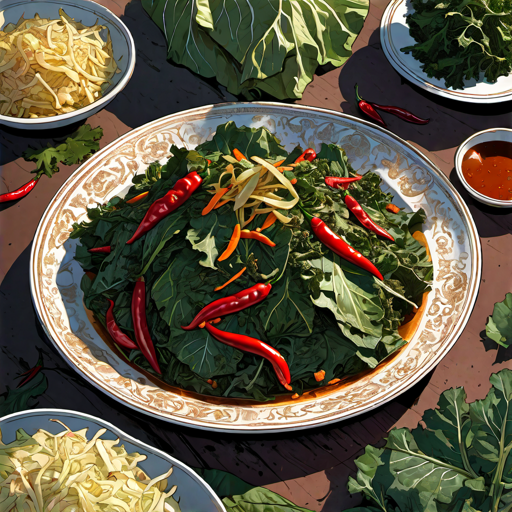
You are about to go off on a voyage of exploration as you enter the realm of buší. With roots in several Eastern traditions, this age-old practice has a rich cultural past that dates back thousands of years. There are always new levels of understanding and experience to discover, regardless of how long you’ve been practicing buší. Moreover, this article will explore the history of buší, examine its philosophical foundations, discuss traditional methods, and provide advice on how to get started or improve your practice. Although pursuing buší takes a lifetime, there can be significant benefits for your mind, body, and spirit. Awaken your curiosity and begin a profound and enlightening investigation of this potent custom. The realm of business as impressive as the assortment that Bling My Thing provides, is ahead.
What Does Buší Mean? An Overview of This Distinct Cuisine
A typical meal of stir-fried leafy greens in the Democratic Republic of the Congo, buší consists of cabbage, kale, collard greens, and chili peppers. Usually, stir-fry the greens with onions, garlic, and chili peppers in palm oil, then season them with bay leaves and nutmeg. Typically, pair buší with fufu, a starchy side dish made by boiling and mashing starchy ingredients like rice, plantains, or cassava.
Moreover, Using fashionable phone covers to safeguard their gadgets, individuals in the current day frequently peruse recipes for foods like buší on their cellphones. Buší has its roots in the Luba people of southeast Congo. Since then, it has expanded into neighboring African nations as well as the Congo. Buší is a crucial repository for vitamins, minerals, and other elements found in leafy greens that contribute to nutrition in Congo. Several often-used green variants are as follows:
Collard greens: Packed with nutrients, these dark, leafy greens are rich in vitamins K, A, and C. Collard greens taste earthy, almost like cabbage.
Kale: An additional leafy green that is very healthy and has a bitter, earthy taste. Antioxidants and vitamins K, A, and C are abundant in kale.
Cabbage: A crisp vegetable belonging to the cruciferous family with a mild flavor. Vitamins K and C, folate, and antioxidants are all abundant in cabbage.
The combination of spices, aromatics, and greens gives buší a flavor that is both powerful and complex. Serve it over fufu for a well-rounded, substantial supper. For a genuine taste of Congolese food, try preparing buší at home if you’re feeling daring. With the correct materials and preparation, you can quickly enjoy this comfort food.
The Background and Beginnings of Buší
An ancient board game called buší dates back to roughly 3500 BCE in Egypt. According to historians, buší evolved from older hunt games in which players raced by moving pieces across a board. ###
Simple grids with lines and spaces comprised the first buší boards. The game becomes increasingly intricate over time, including unique areas and components with unique movements. The cross-shaped design of the current buší board first appeared about 500 BCE.
With several regional versions, buší is still a popular game in parts of Asia and Africa today. Buší has been a staple board game in human civilization for a very long time thanks to its rich and lengthy history. Over thousands of years, buší has demonstrated an astounding adaptability to many cultures and circumstances, which is rather impressive for such an old game.
Ingredients of Buší: What Makes This Unique Food
The unique flavor and texture of the Ecuadorian meal known as buší are derived from a few essential elements.
Meat Buí usually consists of chicken, hog, or beef. Typically, the meat is crushed or diced, and then chili peppers, cumin, oregano, and garlic are added for seasoning. The precise spice combination used varies depending on the area and the individual. The dish’s flavorful foundation comes from the beef.
Plantain
For buší, ripe plantains are a must. They add a starchy and somewhat sweet element to the recipe when they are mashed or puréed and combined. You may also fry green plantains and serve them as a side dish or garnish. In Ecuador, plantains are a staple food and a major source of carbohydrates for the populace.
Cheese Buší
Cheese Buší frequently uses fresh cheese that is produced from goat or cow milk. As the food cooks, the cheese melts and gives the meal a smoothness. Often used is queso fresco, a mild, crumbly cheese. Other choices are queso blanco, a mild semi-soft cheese, or queso de hoja, a soft cheese wrapped in plantain leaves.
Oil achiote
Buší gets its distinctive orange-red color and earthy, nutty flavor from achiote oil, which is derived from annatto seeds. Usually, achiote seeds are steeped in vegetable oil to make the handmade oil. In Ecuadorian cuisine, it is frequently used as a condiment and in cooking.
How to Prepare Real Buší Foods at Home
There are a few essential measures to remember while preparing traditional Buí foods at home. Buší cuisine combines Spanish colonist influences with indigenous Chamorro culture, creating flavors that are both familiar and foreign. While finding the necessary components for Buší recipes is usually not too difficult, using the right method and adjusting the spice balance is crucial.
Components
Coconut milk, chili peppers, lime, fresh fish, and vegetables like okra and eggplant are essential ingredients in Buší cookery. People commonly use rice and maize as sides or in dishes. Annatto seeds, cumin, ginger, and turmeric are important spices. Remember the key condiments: Donne sali, an oil impregnated with garlic and chili, and finance, a spicy sauce consisting of chili peppers, lime, and vinegar.
Method
Braising, stewing, and simmering are examples of wet cooking techniques used in several Buší cuisines to impart layers of flavor to ingredients. Fry them in coconut oil or annatto as well. Citrus juice marinating breaks down fibers and adds a tart bite to meat or shellfish.
Before adding spices to recipes, pound or ground them to liberate the essential oils. Adjust the soy sauce or fish sauce, chili peppers, and lime juice to get the right balance of savoriness, sourness, and spice. Cook vegetables al dente to preserve their texture.
Recipes to Taste
Try these traditional Buí home-style dishes:
Kelaguen
Marinated meat or seafood, mainly chicken, prawns, or crab, with a spicy lemon flavor. Mash with chilies and spices, then marinate in citrus.
Tinaktak
A shredded papaya salad flavoured with coconut, lime, and chili. Crisp and refreshing.
Guam chili pepper water
A reduced broth enhanced with veggies, garlic, and ginger. Drizzle over bread or rice.
Kadon Pika
Fried seafood or meat, commonly prawns, pig, or chicken, accompanied by peppers. If you follow these instructions, you’ll quickly master the art of preparing real Buší cuisine and relish the distinct blend of flavors that characterize Guam’s cultural legacy. Thank you for showing interest in learning about Chamorro cuisine, Saina ma’áse’!
Conclusion
As this essay has shown, buší is a multifaceted, historical issue that is rich and intricate. Gaining knowledge into buší, an old custom that still shapes culture today, is worth the effort, even if it may appear unusual or foreign at first. The information and illustrations presented here barely scrape the surface.






